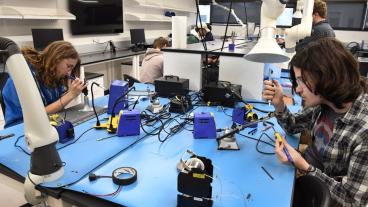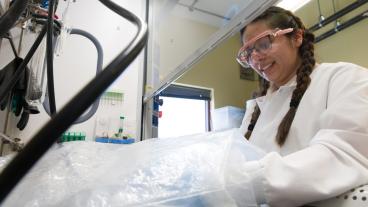Mines researcher contributes to development of new gas storage method that could help next-gen clean energy vehicles

A Colorado School of Mines professor is part of a research team that has designed and synthesized new adsorbent materials with ultrahigh porosity and surface area for the storage of hydrogen and methane for alternative fuel-powered vehicles. These gases are attractive cleaner energy alternatives to traditional fossil fuels, because they emit less carbon dioxide when combusted. Hydrogen, in particular, does not emit CO2 at all.
The new materials belong to a class of designer crystals known as metal-organic frameworks (MOFs) and can store significantly more hydrogen and methane per material volume and mass than conventional adsorbents at much safer pressures and at much lower costs.
Diego Gomez-Gualdron, assistant professor of chemical and biological engineering at Mines, contributed with computational modeling to the Northwestern University-led project. Their study, combining experiment and molecular simulation, was published April 17 by the journal Science.
“For a while now, MOFs have been considered promising for gas fuel storage. But when a MOF would be found to soak a lot of gas per MOF volume, it would turn out to not soak a lot of gas per MOF mass. The opposite was also true,” Gomez-Gualdron said. “What the new materials do is to get closer than ever to that ideal ‘sweet spot’ where it stores a lot of gas both per mass and volume of MOF, which opens the door for storage tanks placed in the vehicle to be both small and light."
On the quest to find that elusive “sweet spot” material, the Northwestern University team had a promising start with one of their MOFs. Yet, it was unclear how the design of such a good MOF could be further improved. Enter the Mines team, which was able to provide the answer with the help of molecular simulation and lots of computational data.
Mines PhD student Ryther Anderson, a co-first author of the study, created more than 2,500 “virtual” MOFs, and using simulations predicted their material and adsorption properties. Analyzing this data, the Mines team was able to pinpoint precise strategies to improve the material design. The experimental team, led by Omar K. Farha, associate professor of chemistry at Northwestern University, then materialized these strategies by synthesizing the new MOFs.
“We’ve developed a better onboard storage method for hydrogen and methane gas for next-generation clean energy vehicles,” Farha said. “To do this, we used chemical principles to design porous materials with precise atomic arrangement, thereby achieving ultrahigh porosity.”
Like other adsorbents, MOFs bind liquid or gaseous molecules to their internal surface. But thanks to its nanoscopic pores, a one-gram sample of the new MOF, named NU‑1501, has an internal surface area that would cover 1.3 football fields.
The new materials also could be a breakthrough for the gas storage industry at large, Farha said, because many industries and applications require the use of compressed gases such as oxygen, hydrogen, methane and others.
MOFs, which can be thought as “nanosponges,” are built from organic molecules and metal ions or clusters which self-assemble to form multidimensional, highly crystalline, porous frameworks. An analogy often offered by MOF experts to picture the structure of these materials is to envision a MOF as a set of connected Tinkertoys, in which the metal ions or clusters are the circular or square nodes and the organic molecules are the rods holding the nodes together.
Hydrogen- and methane-powered vehicles currently require high-pressure compression to operate. The pressure of a hydrogen tank is 300 times greater than the pressure in car tires. Because of hydrogen’s low density, it is expensive to accomplish this pressure, and it also can be unsafe because the gas is highly flammable.
Developing new adsorbent materials that can store hydrogen and methane gas onboard vehicles at much lower pressures can help scientists and engineers reach U.S. Department of Energy targets for developing the next generation of clean energy automobiles.
To meet these goals, both the size and weight of the onboard fuel tank need to be optimized. The highly porous materials in this study balance both the volumetric (size) and gravimetric (mass) deliverable capacities of hydrogen and methane, bringing researchers one step closer to attaining these targets.
The Northwestern researchers conceived the idea of their MOFs and, in collaboration with Gomez-Gualdron’s simulations at Mines, elucidated strategies to push the storage properties of this class of materials. Farha and his team then designed, synthesized and characterized the materials. They also collaborated with scientists at the National Institute for Standards and Technology (NIST) to conduct high-pressure gas sorption experiments. Mines’ contribution to this study was financially supported by Gomez-Gualdron’s NSF CAREER grant.




